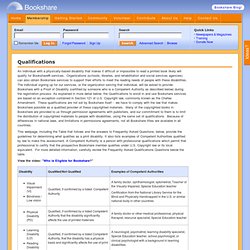

Instapaper: Save interesting web pages for reading later. Computer assistive technology abilityhub for disability and disabilities. Web Accessibility In Mind. Web Content Accessibility Guidelines. You are here: Home > Articles > The Web Content Accessibility Guidelines A WCAG 2.0 Checklist is available for developers to use in implementing and verifying conformance with WCAG 2.0.

The W3C's Web Accessibility Initiative The W3C is an international, vendor-neutral group that determines the protocols and standards for the web. They create the specifications for HTML, CSS, etc. A primary initiative of the W3C is to develop accessibility standards. Version 1.0 of the Web Content Accessibility Guidelines was a major development in making the Internet more accessible to people with disabilities. Over time, WCAG 1.0 began to show its age. The Web Content Accessibility Guidelines 2.0 builds upon the foundation of WCAG 1.0, but also introduces some significant changes worth discussing. The shift from technique-centered guidelines to principle-centered guidelines resulted in a reduced number of top level ideas, or principles. Perceivable Operable Understandable Robust. Web Content Accessibility Guidelines (WCAG) 2.0. This publication has been funded in part with Federal funds from the U.S.

Department of Education, National Institute on Disability and Rehabilitation Research (NIDRR) under contract number ED05CO0039. The content of this publication does not necessarily reflect the views or policies of the U.S. Department of Education, nor does mention of trade names, commercial products, or organizations imply endorsement by the U.S. Web Content Accessibility Guidelines 1.0. W3C Recommendation 5-May-1999 This version: (plain text, PostScript, PDF, gzip tar file of HTML, zip archive of HTML) Latest version: Previous version: Editors: Wendy Chisholm, Trace R & D Center, University of Wisconsin -- Madison Gregg Vanderheiden, Trace R & D Center, University of Wisconsin -- Madison Ian Jacobs, W3C Copyright © 1999 W3C (MIT, INRIA, Keio), All Rights Reserved.

Abstract These guidelines explain how to make Web content accessible to people with disabilities. This is a reference document for accessibility principles and design ideas. This document is meant to be stable and therefore does not provide specific information about browser support for different technologies as that information changes rapidly. This document includes an appendix that organizes all of the checkpoints by topic and priority. Access All WWW Areas. Home > Over toegankelijkheid Een beperking levert tegenwoordig gelukkig niet zo'n groot probleem als vroeger.

De tijd dat een blinde een gedateerd tijdschrift of studiemateriaal 'las', omdat het eerst moest worden omgezet in braille of audio, ligt gelukkig ver achter ons. Veel informatie is (vooral online) best toegankelijk beschikbaar. Qualifications - Bookshare - Accessible Books for Individuals with Print Disabilities. An individual with a physically-based disability that makes it difficult or impossible to read a printed book likely will qualify for Bookshare® services.

Organizations (schools, libraries, and rehabilitation and social services agencies) can also obtain Bookshare services to support their efforts to meet the reading needs of people with these disabilities. The individual signing up for our services, or the organization serving that individual, will be asked to provide Bookshare with a Proof of Disability (certified by someone who is a Competent Authority as described below) during the registration process.
As explained in more detail below, the Qualifications to enroll in and use Bookshare services are based on an exception contained in Section 121 of U.S. Copyright law, commonly known as the Chafee Amendment. These qualifications are not set by Bookshare itself - we have to comply with the law that makes Bookshare possible as a qualified provider of these copyrighted materials. Bookshare - Accessible Books for Individuals with Print Disabilities. FAE: Run FAE. Introduction to Web Accessibility. You are here: Home > Articles > Introduction to Web Accessibility Introduction Most people today can hardly conceive of life without the internet.

Some have argued that no other single invention has been more revolutionary since Gutenberg's printing press in the 1400s. Now, at the click of a mouse, the world can be "at your fingertips"—that is, if you can use a mouse... and see the screen... and hear the audio—in other words, if you don't have a disability of any kind. This introduction should help you understand how people with disabilities use the web, the frustrations they feel when they cannot access the web, and what you can do to make your sites more accessible. The Web Offers Unprecedented Opportunities The internet is one of the best things that has ever happened to people with disabilities. Most newspapers now publish their content online in a format that has the potential to be read by screen readers used by the blind.
ReadPal -Free download to read faster with no stress or glare.